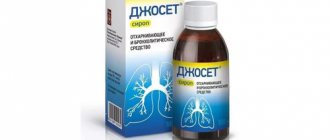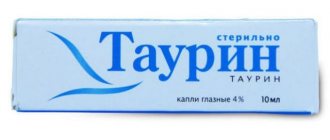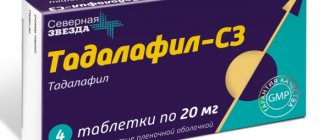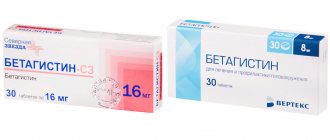Composition and release form
Ambrohexal is available in syrup, tablet and solution formats. Their composition:
| Syrup | Pills | Solution | |
| Description | Clear dark liquid with apricot aroma | White pills | Transparent colorless liquid |
| Concentration of ambroxol hydrochloride, mg | 6 per 1 ml | 30 per 1 piece. | 7.5 per 1 ml |
| Auxiliary components | Water, benzoic acid, levomenthol, glycerol, propylene glycol, hyaetellose, apricot flavor, sorbitol, sodium hydrochloride, fiber | Colloidal silicon dioxide, magnesium stearate, calcium dihydrogen phosphate dihydrate, sodium carboxymethyl starch, corn starch, lactose monohydrate | Water, methyl parahydroxybenzoate, sodium hydroxide, propyl parahydroxybenzoate, citric acid, sodium metabisulfite |
| Package | Bottles of 100 or 250 ml with a measuring spoon in a pack with instructions for use | 10 tablets in a blister pack, in a pack of 2, 3, 5 or 10 packs | Dropper bottles of 50 or 100 ml with a measuring cup included |
| Price, rubles | 125 for 100 ml | 110 for 20 pcs. | 92 for 50 ml |
AMBROHEXAL
– ambroxol hydrochloride (ambroxol)
Composition and release form of the drug
◊ Syrup
colorless to light yellow, transparent or almost transparent.
| 1 ml | |
| ambroxol hydrochloride | 6 mg |
Excipients: benzoic acid – 2 mg, glycerol 85% – 127.5 mg, hyaetellose – 1 mg, sorbitol (70% solution) – 250 mg, apricot flavor – 2.5 mg, propylene glycol – 30 mg, levomenthol – 0.08 mg, purified water – up to 1 ml.
100 ml – dark glass bottles with a dosing device (1) complete with a measuring spoon – cardboard packs.
pharmachologic effect
Mucolytic and expectorant, is the active N-demethylated metabolite of bromhexine. It has secretomotor, secretolytic and expectorant effects.
Stimulates serous cells of the bronchial mucosa, increases the motor activity of the ciliated epithelium by affecting type 2 pneumocytes in the alveoli and Clara cells in the bronchioles, enhances the formation of endogenous surfactant - a surfactant that ensures the sliding of bronchial secretions in the lumen of the respiratory tract.
Ambroxol increases the proportion of the serous component in the bronchial secretion, improving its structure and helping to reduce viscosity and thin the sputum; as a result, mucociliary transport improves and the removal of sputum from the bronchial tree is facilitated.
When ambroxol is taken orally, the effect, on average, occurs after 30 minutes and lasts 6-12 hours, depending on the single dose.
Pharmacokinetics
After oral administration, ambroxol is quickly and almost completely absorbed. Tmax is 1-3 hours. Plasma protein binding is approximately 85%. Penetrates the placental barrier and is excreted in breast milk.
Metabolized in the liver to form metabolites (dibromanthranilic acid, glucuronic conjugates), which are excreted by the kidneys. It is excreted primarily by the kidneys - 90% in the form of metabolites, less than 10% unchanged. T1/2 from plasma is 7-12 hours.
T1/2 of ambroxol and its metabolites is approximately 22 hours.
Due to high protein binding and large Vd, as well as slow re-penetration from tissues into the blood, significant elimination of ambroxol does not occur during dialysis or forced diuresis. The clearance of ambroxol in patients with severe liver failure is reduced by 20-40%. In severe renal failure, T1/2 of ambroxol metabolites increases.
Indications
For oral administration
Diseases of the respiratory tract, accompanied by the release of viscous sputum and difficulty in sputum discharge: acute and chronic bronchitis; pneumonia; bronchial asthma; bronchiectasis; COPD
For intravenous administration
Diseases of the respiratory tract with the release of viscous sputum and difficulty in sputum discharge in cases where it is necessary to obtain a rapid therapeutic effect or it is impossible to take the drug orally: acute and chronic bronchitis; pneumonia; bronchial asthma; bronchiectasis; stimulation of surfactant synthesis during respiratory distress syndrome in premature infants and newborns (as part of complex therapy).
Contraindications
Hypersensitivity to ambroxol or auxiliary components of the drugs; I trimester of pregnancy; lactation period (breastfeeding); congenital fructose intolerance (for dosage forms containing fructose); children under 6 years of age (for tablets); children under 12 years of age (for extended-release capsules).
Carefully:
impaired bronchial motility and increased mucus secretion (for example, with rare fixed cilia syndrome); renal failure and/or severe liver failure; peptic ulcer of the stomach and duodenum (including a history); II and III trimesters of pregnancy; children under 2 years of age (oral solution; only as prescribed by a doctor).
Dosage
The duration of treatment is determined by the doctor individually and depends on the severity of the disease. If it is necessary to use the drug for more than 4-5 days, consult a doctor.
For oral administration
Take orally after meals with sufficient liquid.
Dosage forms of usual duration of action (tablets, syrup, oral solution, lozenges)
Adults and children over 12 years of age:
30 mg 2-3 times/day for the first 2-3 days, then 30 mg 2 times/day.
Children aged 5 to 12 years:
30-45 mg/day in 2-3 doses.
Children aged 2 to 5 years:
22.5 mg/day in 3 divided doses.
Children under 2 years old:
15 mg/day in 2 divided doses. The drug is prescribed only under the supervision of a doctor.
Extended release capsules
Adults and children over 12 years of age:
75 mg 1 time/day.
For intravenous administration
Enter
intravenously in a slow stream or drip.
Adults:
30-45 mg/day, 2-3 times/day in divided doses. In severe cases, the dose can be increased to 60-90 mg/day, 2-3 times/day in divided doses.
For children
The daily dose is usually 1.2-1.6 mg/kg body weight.
Children over 6 years of age:
30-45 mg/day, 2-3 times/day in divided doses.
Children aged 2 to 6 years:
22.5 mg/day, 3 times/day in divided doses.
Children under 2 years of age:
15 mg/day, 2 times/day in divided doses.
For respiratory distress syndrome
in
newborns and premature infants,
the daily dose is 30 mg and is usually divided into 4 separate administrations.
Treatment of children under 2 years of age
should only be carried out under the supervision of a physician.
Parenteral use is stopped after the disappearance of acute manifestations of the disease and switched to taking abmroxol orally in appropriate dosage forms.
In patients with renal failure
and
severe renal failure,
ambroxol should be used at longer intervals or in reduced doses.
Allergic reactions:
rarely - skin rash, urticaria, exanthema, facial swelling, shortness of breath, itching, fever; frequency unknown - anaphylactic reactions, including anaphylactic shock, angioedema, pruritus, allergic contact dermatitis.
From the digestive system:
often – nausea; uncommon – vomiting, diarrhea, dyspepsia, abdominal pain.
From the nervous system:
often - dysgeusia.
For the skin and subcutaneous tissues:
very rarely - toxic epidermal necrolysis (Lyell's syndrome), Stevens-Johnson syndrome; frequency unknown - acute generalized eczematous pustulosis.
From the respiratory system:
often - decreased sensitivity in the mouth or pharynx; rarely – dryness of the mucous membrane of the respiratory tract, rhinorrhea; in isolated cases – dryness of the pharyngeal mucosa.
Drug interactions
Antitussives (eg, codeine)
– due to the suppression of the cough reflex, accumulation of sputum in the lumen of the respiratory tract is possible, making it difficult to remove it (simultaneous use is not recommended).
Amoxicillin, doxycycline, cefuroxime, erythromycin
– increased penetration of antibiotics into bronchial secretions.
special instructions
Ambroxol should not be taken simultaneously with antitussive drugs that can inhibit the cough reflex, for example, codeine, because this may make it difficult to remove liquefied mucus from the bronchi.
Ambroxol should be used with caution in patients with a weakened cough reflex or impaired mucociliary transport due to the possibility of sputum accumulation.
Patients taking ambroxol are not recommended to perform breathing exercises due to difficulty in sputum discharge. In critically ill patients, aspiration of liquefied sputum should be performed.
You should not take ambroxol immediately before bed.
In patients with bronchial asthma, ambroxol may increase cough.
In patients with severe skin lesions - Stevens-Johnson syndrome or toxic epidermal necrolysis - a flu-like condition may be observed in the early phase: fever, body pain, rhinitis, cough, pharyngitis. During symptomatic therapy, it is possible to erroneously prescribe mucolytic drugs such as ambroxol hydrochloride.
Pregnancy and lactation
Ambroxol is contraindicated in the first trimester of pregnancy. If it is necessary to use it in the second and third trimesters, the potential benefits of therapy for the mother and the possible risk to the fetus should be assessed.
If it is necessary to use ambroxol during lactation, the issue of stopping breastfeeding should be decided.
Use in childhood
Application is possible in accordance with the dosage regimen.
Use in old age
The drug is approved for use in elderly patients
The description of the drug AMBROGEXAL is based on officially approved instructions for use and approved by the manufacturer.
Found an error? Select it and press Ctrl+Enter.
Source: https://health.mail.ru/drug/ambrogeksal/
Properties of the drug
The mucolytic component ambroxol with an expectorant effect enhances the production of sputum by bronchial cells. This leads to the initiation of cell synthesis of enzymes that break down the intramolecular bonds of mucopolysaccharides, which is the basis of sputum. The viscosity of mucus decreases, mucociliary clearance increases - the movement of bronchial cilia aimed at removing sputum.
Along with mucus, foreign agents that cause inflammation and cough are removed from the respiratory tract - bacteria, dust, viruses, allergens, chemical compounds. This helps speed up the transition of a dry (non-productive) cough to a wet (productive) cough and reduce its intensity. After taking the drugs, the therapeutic concentration of ambroxol is achieved within 25 minutes and lasts for 9 hours. Metabolism of the active component takes place in the liver, breakdown products are excreted in the urine. The half-life is 12 hours.
Mechanism of action
In a healthy person, mucus is produced in small quantities by the respiratory system to remove the smallest particles of dust, microorganisms and other contaminants. Sputum from the bronchi rises to the trachea under the action of cilia of the mucosal epithelium. In the trachea and larynx, thick mucus irritates the receptor zones, and a reflex cough occurs to remove sputum.
In diseases of an inflammatory nature, the composition and viscosity of the mucus changes, which begins to stick to the mucous membrane of the respiratory tract, where harmful bacteria and viruses develop. This leads to obstruction of the bronchi and partial blockage of small bronchioles, which leads to hypoxia of all organs. To prevent these processes, medications are used to thin the mucus and make it easier to cough up.
The drug "Ambrohexal" (solution) has a secretomotor, secretolytic and expectorant effect. Instructions for use describe in detail the mechanism of liquefaction of mucus in the respiratory tract due to the rupture of disulfide bridges in mucopolysaccharide molecules and their subsequent depolymerization. The active component of the drug restores the balance between the serous and mucous components in the sputum, makes the cilia in the ciliated epithelium move more strongly. This helps to enhance mucociliary clearance, during which various biologically active agents are removed from the mucous membrane of the respiratory tract.
Facilitation of the removal of sputum from the respiratory system occurs by reducing its viscosity due to the activation of hydrolyzing enzymes and increased release of lysosomal structures from large neurons called Clark cells.
In chronic respiratory diseases, a combination of surface-active phospholipids and inflammatory proteins occurs, which leads to a change in properties and a decrease in the synthesis of surfactants. It is these substances that help maintain the alveolar structure of the lungs and regulate pressure in them. With the introduction of ambroxol, the synthesis and secretion of surfactants in the alveoli increases. This action is used to stimulate the prenatal development of the respiratory tract in newborns, as a result of which the baby will be able to breathe air for the first time without much difficulty.
The activity of the drug "Ambrohexal" (oral solution) begins half an hour after administration and lasts from 6 to 12 hours.
Indications for use
According to the instructions, the main indications for the use of Ambrohexal are lung diseases accompanied by inflammation with the production of thick sputum, dry cough and difficulty removing mucus. These are the following diseases:
- infectious bronchitis;
- bronchial asthma;
- tracheitis;
- chronic obstructive bronchitis;
- cystic fibrosis;
- bronchiectasis;
- pneumonia;
- inflammatory processes in the bronchial tree.
Action of Ambrohexal
This drug has an expectorant effect by stimulating the ciliated epithelial layer, and also has the following properties, which determine the therapeutic effect of Ambrohexal tablets and its other dosage forms:
- Strengthens bronchial motility.
- Stimulates the discharge of tracheobronchial mucus.
- Reduces cough reflex.
- Liquefies mucus, reducing its viscosity.
The drug Ambrohexal effectively cleanses the bronchi from adhering and difficult to separate sputum along with harmful microorganisms, the proliferation of which leads to the development of the inflammatory process and the progression of the disease. As a result, the patient gets rid of a painful dry cough and begins to cough up excess mucus.
Directions for use and dosage
Depending on the type of drug, its dosage, method of administration and frequency of administration differ. The latter depends on the age and characteristics of the patient. According to the instructions, you should not take the product for more than 4-5 days. The beneficial properties of Ambrohexal are enhanced by large fluid intake. Doctors advise drinking a lot of juices, tea, and water during treatment.
AmbroHEXAL tablets
As indicated in the instructions, the tablets are taken orally after meals, washed down with a sufficient amount of water. Patients over 12 years of age are advised to take one tablet three times a day during the initial 2-3 days of the disease, then the dose is reduced to one tablet taken twice a day. Children 6-12 years old are advised to take 1/2 tablet 2-3 times a day.
AmbroHEXAL solution
The drug in the form of a solution can be taken orally or inhaled. In the first case, it is drunk after meals, diluted with juice, milk or water. Patients over 12 years old are given 4 ml (80 drops) for the initial 2-3 days three times a day, after that 4 ml twice a day. Children 5-12 years old are prescribed 2 ml 2-3 times a day, 2-5 years old - 1 ml three times a day, up to 2 years old - under the supervision of a doctor, 1 ml twice a day.
For inhalations, patients over five years old use 2-3 ml of solution 1-2 times a day, and those under 5 years old use 2 ml 1-2 times a day. The required amount of the medicine, warmed up to body temperature, is mixed with saline solution 1:1. Inhalations are carried out so that a deep breath does not lead to coughing impulses. For bronchial asthma, procedures are carried out after taking bronchodilators.
Articles on the topic
- Rabelok - instructions for use and analogues
- Bronchorus - instructions for use, indications, dosage and side effects
- Spondyloarthrosis of the lumbosacral spine - signs, diagnosis and therapy
Syrup
Ambrohexal syrup is also intended for oral administration, which, according to the instructions, patients over 12 years of age take one spoon (5 ml) three times a day for the first 2-3 days, then a measuring spoon twice a day. Children 6-12 years old are given half a spoon 2-3 times daily, 2-5 years old - a quarter spoon 3 times daily, under 2 years old - a quarter scoop twice daily.
Similar drugs:
- Mucaltin Oral tablets
- Omnitus Syrup
- Cough control tablets Oral tablets
- Tavipek Capsule
- Licorice root syrup (Glycyrrihizae radicis syrup) Syrup
- Marshmallow syrup (Althaeae sirupus) Syrup
- Sodium bicarbonate Solution for infusion
- Potassium iodide (Potassium iodide) Substance
- Sodium hydrocarbonate Solution for infusion
- Mucaltin-LekT (Mucaltin) Oral tablets
** The Drug Directory is intended for informational purposes only. For more complete information, please refer to the manufacturer's instructions. Do not self-medicate; Before starting to use the drug AmbroHEXAL, you should consult a doctor. EUROLAB is not responsible for the consequences caused by the use of information posted on the portal. Any information on the site does not replace medical advice and cannot serve as a guarantee of the positive effect of the drug.
Are you interested in the drug AmbroHEXAL? Do you want to know more detailed information or do you need a doctor's examination? Or do you need an inspection? You can make an appointment with a doctor - the Euro lab is always at your service! The best doctors will examine you, advise you, provide the necessary assistance and make a diagnosis. You can also call a doctor at home . Euro lab clinic is open for you around the clock.
** Attention! The information presented in this medication guide is intended for medical professionals and should not be used as a basis for self-medication. The description of the drug AmbroHEXAL is provided for informational purposes and is not intended for prescribing treatment without the participation of a doctor. Patients need to consult a specialist!
If you are interested in any other drugs and medications, their descriptions and instructions for use, information about the composition and form of release, indications for use and side effects, methods of use, prices and reviews of drugs, or you have any other questions and suggestions - write to us, we will definitely try to help you.
special instructions
Before you start taking medications, you should read the instructions. Helpful tips from the special instructions section:
- The use of the products in pregnant and lactating women and children under two years of age is possible after consultation with a doctor.
- The tablets are taken after meals to reduce their negative effect on the mucous membrane of the digestive organs.
- The doctor can increase the course of treatment beyond 4-5 days if there is a continuing dry cough and stagnation of sputum in the bronchi.
- The drugs are used with caution for pathologies of the liver and kidneys, and organ function is regularly monitored during therapy.
- You can take the drugs while operating vehicles and machinery.
Ambrohexal for inhalation
: 5 / 5
Ambrohexal is available in the form of a solution for oral administration and inhalation. Sold in 50 ml bottles. The main purpose is to facilitate the removal of sputum.
Used as a primary, auxiliary agent as part of complex therapy. Combines well with other medications prescribed for the treatment of diseases of the upper and lower respiratory tract.
The manufacturer is Sandoz, Germany.
Composition, pharmacological action
The active ingredient is ambroxol. 1 ml contains 20 drops. The set includes a measuring cup. The bottle has a convenient dropper.
A mucolytic drug with an expectorant effect thins mucus, facilitates and stimulates its excretion. Prescribed for diseases of the respiratory system associated with difficulty removing mucus from the bronchi and lungs.
In addition, it is used as an adjuvant in the treatment of sinusitis.
Indications for use are acute and chronic respiratory diseases:
- bronchitis;
- COPD;
- asthma;
- pneumonia;
- bronchiectasis.
The effect of ambroxol after oral administration occurs within 20 minutes, administration through an inhaler - 5 minutes. Lasts about 8 hours.
Ambrohexal for oral administration
The drug is taken after meals. It can be dissolved in any liquid, including milk. 1 ml of medication contains 7.5 mg of active substance.
To accurately determine the dosage, you should know that 1 ml equals 20 drops. The duration of therapy is determined by the doctor. The average course of therapy is 5 days. The dosage is selected individually.
Depends on the severity of the disease, diagnosis, and age of the patient.
| Age | Amount of drug in ml | Reception mode |
| Adults, children over 12 years old | 4 | 2-3 times |
| Children 5-12 years old | 2 | 2-3 |
| Children 2-5 years old | 1 | 3 |
| Children under 2 years old | 1 | 2 |
Ambrohexal drops for inhalation and internal administration are not prescribed for individual intolerance. It manifests itself as an allergic rash on the skin, deterioration in health. The dosage should not be exceeded to avoid side effects.
Ambrohexal for inhalation: instructions for use
Use through a nebulizer is prescribed for difficult removal of mucus from the bronchi and lungs. If the cough is wet and expectorates well, the medicine is taken orally to speed up this process. For obstructive bronchitis and pneumonia, the effect of drops is not enough. A deeper introduction of active substances is required.
Inhalations with Ambrohexal are done 1-2 times a day, depending on the complexity of the disease. After you feel better, the frequency of breathing procedures is reduced to 1 time. In this case, it is recommended to breathe 2 hours before bedtime. After 5 minutes, the cough intensifies, mucus is removed, and breathing improves.
Instructions:
| Age | Amount of drug in ml | Daily regime |
| Adults, children over 12 years old | 3 | 1-2 |
| Children over 5 years old | 2 | |
| Children under 5 years old | 1-2 |
The dose is selected by the attending physician. The duration of the course is on average 5 days. To administer medication through a nebulizer, use any device except steam inhalers.
Use in adults
The medicine should be administered by inhalation during the period of acute symptoms in a dose of 3 ml. The dose may be increased according to the doctor's recommendation. Inhalation is carried out in the morning after waking up, in the evening - 2 hours before bedtime. This regime prevents congestion in the respiratory organs and promptly removes mucus.
Ambrohexal for inhalation during pregnancy, according to the instructions, is prohibited from use in the first trimester. In the future, the drug can be prescribed in case of urgent need, under the strict supervision of specialists. Contraindications also include lactation.
Ambrohexal for inhalation for children
A mucolytic expectorant is prescribed to children almost from birth. The pediatrician should tell you how many drops of Ambrohexal for inhalation to give to infants. The daily dose should not exceed 1 ml.
Considering that it contains 20 drops. One procedure takes up to 10 drops. For babies over 1 year of age, the medicine is administered by inhalation according to the instructions.
Since deep breathing causes coughing, it is better for children to use a mask instead of a mouthpiece. Breathe evenly and calmly.
How to dilute Ambrohexal for inhalation
Saline solution is used as a solvent. It is prohibited to use distilled or boiled water. The proportions depend on the dose of the medication.
The total amount of the prepared Ambrohexal solution for inhalation should not exceed 4 ml. If 1 ml is prescribed, add 3 ml of saline solution, 3 ml, respectively 1 ml.
How to dilute the Ambrohexal inhalation solution is described in the instructions, but the doctor can make adjustments.
After dilution with saline, the medicine can be stored for a day in a cool place. As a rule, they are left in the refrigerator. Must be used within 12 hours. The shelf life of the undiluted solution is 2 years from the date of manufacture. After the first application, the period is reduced to 12 months.
How to breathe Ambrohexal through a nebulizer
It is recommended to prepare the solution immediately before use. The prescribed dose is poured into the liquid reservoir and saline is added. In order for the procedure to be as effective as possible, you must adhere to the following instructions:
- Breathe the medicine while sitting. When the camera angle changes, the effectiveness of the event decreases.
- Duration: 10 minutes for adults, 5 minutes for children.
- After completion, it is not recommended to drink or eat for 1 hour, and you should not go outside for 2 hours.
- If other medications are prescribed at the same time, a break of 1-2 hours must be observed.
Some readers ask whether Ambrohexal syrup is available for inhalation. There is no such form of the drug; drops are used for administration through a nebulizer .
Ambrohexal or Lazolvan for inhalation
It is impossible to say unequivocally which is better. Medicines are analogues. Active substance ambroxol. The dosage in 1 ml of the finished drug is identical. There are no differences in application in the instructions. Only the manufacturer and price differ. Ambrohexal costs 90 rubles, Lazolvan – 330 rubles.
The drugs combine well with other medications for the treatment of respiratory diseases and rarely cause adverse events. However, the issue of replacing one medicine with another should be discussed with your doctor.
Ambrohexal during pregnancy
The drugs should not be used in the first trimester of pregnancy. This threatens the development of abnormalities in the growth and development of the fetus. The second and third trimester of bearing a child are relative contraindications, as is lactation (breastfeeding). The doctor prescribes Ambrohexal if the benefit to the mother outweighs the potential risk to the newborn.
Contraindications for inhalations
The use of Ambrohexal is not recommended in the first trimester of pregnancy. The same applies to the stage of breastfeeding, children up to six years of age (for tablets this is a 100% contraindication, for a solution it is recommended to discuss with a specialist). Other restrictions include:
- lactase deficiency in the body;
- lactose intolerance and glucose-galactose malabsorption;
- hereditary form of lactose intolerance;
- increased degree of susceptibility to ambroxol and other components of the presented drug.
When talking about Ambrohexal (solution for oral administration and inhalation), we should not forget that this will be unacceptable for peptic ulcers of the stomach and duodenum. This must be remembered, given the likelihood of an exacerbation. Also, the use of Ambrohexal should be limited in case of renal and liver failure, in the second and third trimester of pregnancy. In order for the recovery course to be 100% effective, you will need to comply with all the conditions associated with the dosage of the solution for adults and children.
You will be interested in the article - Pulmicort for inhalation for children, instructions on how to correctly carry out the procedure.
Side effects
Ambrohexal is well tolerated, rarely causing side effects. The instructions highlight negative actions:
- allergies, skin rash;
- nausea, cramping abdominal pain, vomiting, dry mouth, bloating;
- taste disturbance;
- hypotrophy of the skin epithelium;
- general weakness, fever, headache.
The drug is characterized by low toxicity and a wide range of applications, so cases of overdose practically do not occur. If the dose is exceeded, nervous excitement, dryness of the mucous membranes of the digestive and respiratory tracts, and diarrhea may develop. If an overdose is suspected, gastric and intestinal lavage and detoxification should be performed.
Side effects
Ambroxol in AmbroHEXAL tablets is well tolerated. Sometimes it is possible to develop its side effects, which are characterized by the following manifestations:
- Symptoms of digestive system dysfunction are nausea, vomiting, periodic bloating, which are accompanied by dry mucous membranes. Somewhat less often, abdominal pain may appear, which is spastic in nature.
- From the nervous system – a slight disturbance of taste sensations.
- A change in a person’s general well-being after taking the drug, which is accompanied by headache, fever, and general weakness.
- Allergic reactions to any of the components of the drug, including ambroxol, manifest themselves in the form of a rash on the skin, which may be accompanied by itching. With a more pronounced reaction of the body, urticaria develops (a rash on the skin appears against the background of slight swelling, which looks like a nettle burn), Quincke's edema (angioedema of the skin and subcutaneous tissue in the face or external genitalia). It is extremely rare to develop anaphylactic shock - a severe allergic reaction in which a progressive decrease in systemic blood pressure and loss of consciousness occurs.
Cases of the development of severe skin lesions (Steven-Jones syndrome), the appearance of which was associated with taking drugs based on ambroxol, have been described. However, such skin lesions are associated more with the underlying disease rather than with ambroxol. If any manifestations, symptoms or reactions to taking AmbroHEXAL tablets appear, you must stop taking them and consult a doctor.
Analogs
Most drug substitutes contain ambroxol or another active substance with a similar effect. Analogues of the product include:
- Lazolvan is a secretolytic solution for inhalation based on ambroxol.
- Ambrobene - expectorant tablets, capsules, syrup, solution for inhalation and infusion containing ambroxol.
- Ambroxol is a secretomotor tablet based on the component of the same name.
- Flavamed – secretolytic tablets and oral solution containing ambroxol.
- Halixol - mucolytic tablets and syrup based on ambroxol.
- Bronchovern - secretolytic drops containing ambroxol.
Analogues of the drug
There are many drugs similar to Ambrohexal in composition and principle of action, available in the form of tablets, syrup, etc. List of similar drugs:
- Ambrobene.
- Lazolvan.
- Ambroxol.
- Flavamed in the form of solution and tablets.
- Neo-bronchol tablets.
- Ambrosan.
- Bronchovern.
- Halixol in tablets and liquid form.
- Flavamed max – effervescent tablets.
- Mucobron.
- Deflegmin.
- Lazolangin.
| A drug | Photo | Price |
| Ambrobene | from 120 rub. | |
| Lazolvan | from 170 rub. | |
| Ambroxol | from 52 rub. | |
| Flavamed | from 135 rub. | |
| Ambrosan | from 116 rub. | |
| Halixol | from 119 rub. |
Ambrohexal should not be replaced with an analogue without the consent of the attending physician, since the concentration and types of active and auxiliary substances for these drugs are different.
Overdose
As with other medications, when using ambrohexal it is necessary to strictly adhere to the dose of the drug. If the instructions for use are not followed, an overdose occurs. It manifests itself in the form of nausea, vomiting, diarrhea, and abdominal pain. These symptoms should immediately alert the patient.
If such phenomena occur, it is necessary to stop taking the drug, carry out symptomatic treatment and consult a specialist for medical help. It is better not to self-medicate, as incorrect dosing of medications can worsen the patient’s condition and cause severe harm to his health.
It should be noted that it is not recommended to perform the procedure without saline solution, since part of the drug will remain in the inhaler and the patient will receive a dose less than necessary. If the inhaler is filled with a large amount of ambrohexal, this can lead to an overdose of the drug.
Ambrohexal for inhalation should be diluted with saline solution










